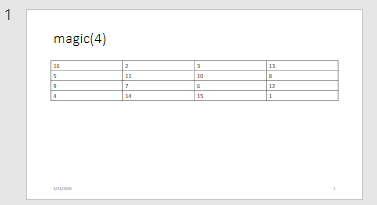mlreportgen.ppt.Slide クラス
名前空間: mlreportgen.ppt
プレゼンテーションのスライド
説明
mlreportgen.ppt.Slide クラスのオブジェクトは、Microsoft® PowerPoint® プレゼンテーションのスライドを表します。Slide オブジェクトを作成してプレゼンテーションに追加するには、mlreportgen.ppt.Presentation オブジェクトの add メソッドを使用します。add メソッドは Slide オブジェクトを返します。Slide オブジェクトのメソッドを使用して、スライド コンテンツの追加、検索、および置換を行うことができます。
mlreportgen.ppt.Slide クラスは handle クラスです。
プロパティ
メソッド
例
バージョン履歴
R2015a で導入
